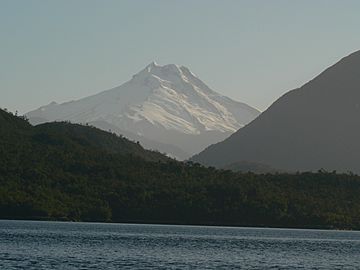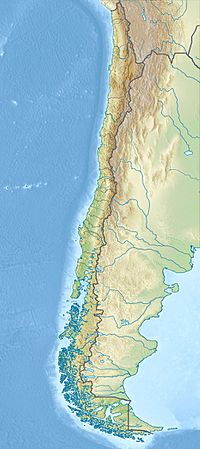Cerro Macá facts for kids
Quick facts for kids Cerro Macá |
|
|---|---|
 |
|
| Highest point | |
| Elevation | 2,300 m (7,500 ft) |
| Prominence | 2,066 m (6,778 ft) |
| Listing | Ultra |
| Geography | |
| Location | Chile |
| Parent range | Andes |
| Geology | |
| Mountain type | Stratovolcano |
| Last eruption | 1560 ± 110 years |
Cerro Macá is a cool stratovolcano in Chile. It's located in the Aysén region, near the Aisén Fjord and the Moraleda Channel. This volcano is covered in glaciers and is part of the huge Andes mountain range.
What is Cerro Macá?
Cerro Macá is a type of volcano called a stratovolcano. This means it's a tall, cone-shaped volcano built up over time by many layers of hardened lava, ash, and rocks. It sits along a major crack in the Earth's crust called the Liquiñe-Ofqui Fault Zone.
How Big is it?
Cerro Macá is a fairly small volcano in terms of its total size, with a volume of about 39 cubic kilometers. Its highest point is around 2,300 meters (about 7,546 feet) above sea level. In 2011, its glaciers covered an area of about 27.62 square kilometers (10.66 square miles).
The volcano's shape shows it has been worn down a bit over time. There's a large, steep dip near its top. This dip might have formed when a part of the volcano collapsed. You can also find smaller cones made of ash and rock, along with lava flows, on its sides. Some of these even reach down to sea level in the Bahia Aysen area.
Where is it Located?
Cerro Macá is part of the southernmost Southern Volcanic Zone of Chile. This area has many volcanoes because of something called subduction. Subduction happens when one of Earth's large plates, like the Nazca Plate, slides underneath another plate. This process creates magma, which then rises to form volcanoes.
Other volcanoes in this region include Melimoyu, Mentolat, Cay, and Cerro Hudson. Cerro Macá itself is mostly made of two types of volcanic rock: basalt and basaltic andesite.
Past Eruptions
Scientists have found evidence of past eruptions from Cerro Macá. About 1,440 years ago, there was a moderate explosive eruption. This eruption spread a layer of ash and rock, called the MAC1 tephra, which was about 10 to 15 centimeters (4 to 6 inches) thick, even 70 kilometers (about 43 miles) east of the volcano. Ash from other past eruptions has also been found near Cochrane Lake.
A more recent eruption happened around 1560. This eruption came from a smaller cone called Bahía Pérez, located on the volcano's southwestern side. People also observed some volcanic activity near Ensenada Pérez, close to Macá's southwestern side, in the early 1900s.
See also
- List of volcanoes in Chile
- List of Ultras of South America
 In Spanish: Volcán Macá para niños
In Spanish: Volcán Macá para niños


